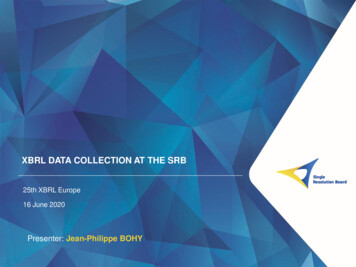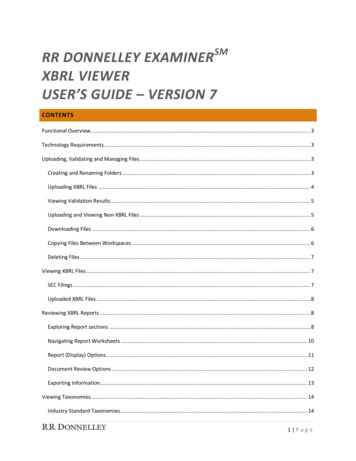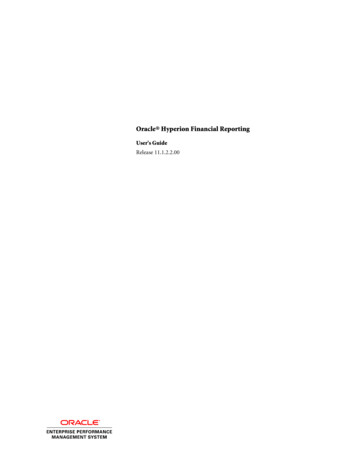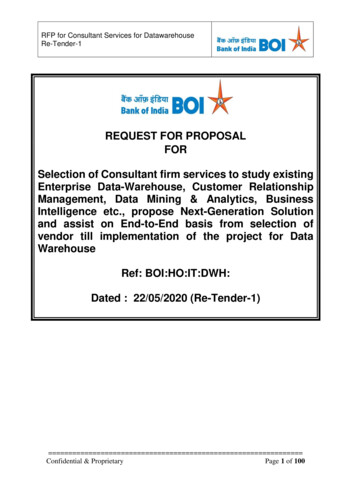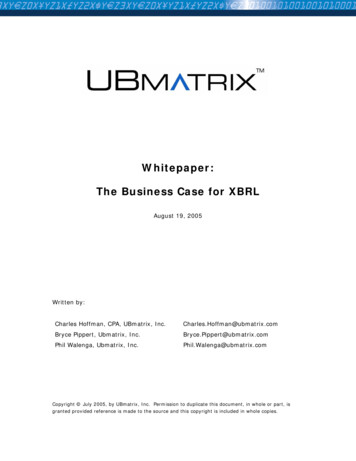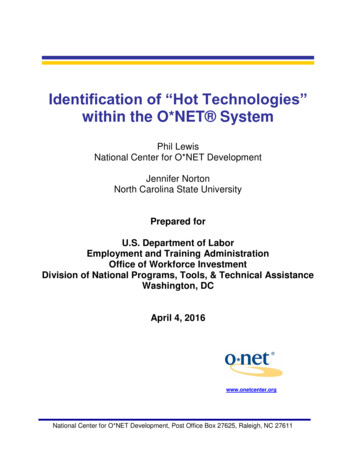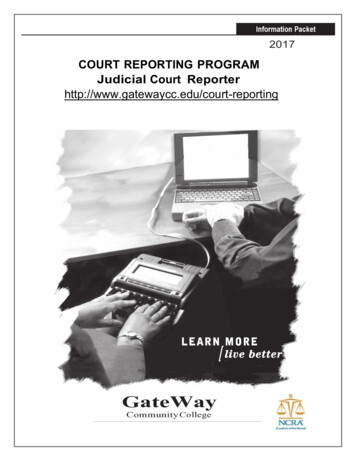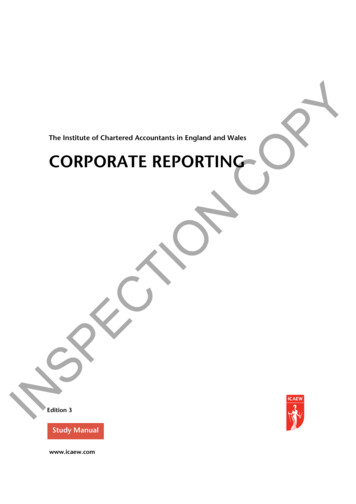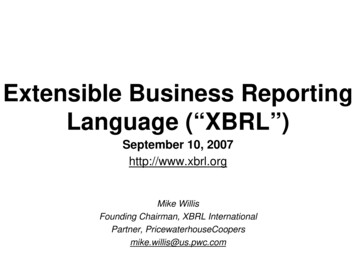
Transcription
Extensible Business ReportingLanguage (“XBRL”)September 10, 2007http://www.xbrl.orgMike WillisFounding Chairman, XBRL InternationalPartner, PricewaterhouseCoopersmike.willis@us.pwc.com
Discussion Topics What is XBRL?Where is XBRL relevant?What are the benefits / costs?Where do you implement?How do you realize the benefits?Background Questions?You are:A.B.C.D.E.In Auditing?In Tax?In industry?In government/not-for-profit?Retired and here for the fun of it?You would rate your knowledge of XBRL as:A. Never heard of itB. Heard of it but don’t know what it isC. Aware of it but not sure what it does or why it isrelevantWhat is XBRL?What is XBRL? eXtensible Business Reporting Language International platform for business reporting An information standard that enhances the quality andAn InternationalBusinessforInformationefficiencyof business informationinternal and externalFormat Standardconsumers Supply chain understanding of a standardized way tocommunicate business information Provides information with identity and context that can beunderstood by a range of software applications allowingseamless interface with databases, business reportingsystems and spreadsheets Can be used to enhance compliance processes1
XBRL International, independent non-profit consortium Develops and maintains the XBRL StandardRecognizes and encourages XBRL best practices (approves taxonomies)Provides a framework for further developmentFacilitates knowledge sharing with members & supports XBRL talySouth AfricaIndiaRussiaXBRL – More Than Just DefinitionsStandardizationReferencesLabelGAAP I.2.(a)InstructionsAd Hoc 现金等价物Geld&ennahe mulasCash Currency DepositsCash 0ContextsSingaporeAustraliaNewZealandValidationUS FY2004BudgetedUnited ArabEmiratesWhat does it look like?SpreadsheetsSo what.1. Are not that pervasive in compliance processes2. Contain many of the control processes relevantto compliance processes3. Are difficult to manage4. Are the primary application for aggregation andanalysis of information for enterprise decisionanalysis What does XBRL look like? Example here Example here What does a Taxonomy look like? Example here How does it make your life better? Example here Example here2
PublishAccessWhere is XBRL relevant?Business ReportingProcessesAnalyzeValidateXBRL Regulatory Adoption – some ofthose publicly announcedThe business reporting supply RLLedgerInternalBusinessReportingXBRLExternal ng,RegulationEconomicPolicymakingGovernment Agencies Australian Government Australian Tax Office Committee of European BankingSupervisors (CEBS)/COREP Chinese Securities RegulationCommission (CSRC) {sponsoringShenzen and Shanghai exchanges} FinancialPublishersand sManagementAccountantsAuditors InvestorsRegulatorsCentralBanksDutch GovernmentSpanish Stock ExchangeCommission – 3000 companiesStatistics Dept of IrelandOther Bank of JapanBundesbankEurostatFinancial Service Agency ofJapan The Irish RevenueCommercial Financial Services andOthers Canadian Securities Regulators KOSDAQ – Korea Bank of Spain National Bank of Belgium National Tax Agency of Japan New Zealand Exchange U.S. Securities & ExchangeCommission Shanghai Stock Exchange s Shenzhen Exchange Singapore ACRA Tokyo Stock Exchange UK Companies House UK Inland Revenue/HMRC US Federal Financial InstitutionsExamination Council (includesFDIC)Software Vendors3
The Dutch Taxonomy Projecthttp://www.xbrl-ntp.nl/english“The Dutch government intends toreduce the administrative burden ofbusinesses with 25 percent.”Banco de EspanaXBRL SPAINGOALMAIN INICIATIVESLATINOAMERICA APPROACH3 Reasons why XBRL is important toCFOs CFOs want to tell your own storyII. Taxonomies building and implementation2005-2007Spanish TaxonomiesDone / DevelopingIPPPublic Periodic InformationStock Exchange Sup.PGC90GAAP 1990ICAC (Government)SSTProperty Appraisal CompaniesBank of SpainES-BE-FSFinancial Information Exch.Bank of SpainES-BE-CBxCentral Balance SheetBank of SpainSEPBLACAnti Money LaunderingBank of SpainBPBalance of PaymentsBank of SpainIGAEPublic Sector AccountingGov. AccountingINEStructural StatisticsNat’l Statistics InstituteRSCCorp. Social ResponsibilityAECA (Accountants)LENLOCRendering of AccountsLocal Entities Superv. CFOs don’t want to use standard reportingtemplates CFOs need to lower your reporting costs andenhance your related controls4
Closer Look at Supply Chain distortionCloser Look at Supply Chain distortionIBM Form 10-K Cisco Form 10-K% Provided% ProvidedReported ElementsForm 10-K AggregatorIncome Statement90 48% 43Balance Sheet785368%Cash Flow Statement64 73% 47 Reported ElementsIncome StatementBalance SheetCash Flow StatementForm 10-K Aggregator805366%785874%703956% Total elements provided 4500Total elements provided 450011% 500 50011%Closer Look at Supply Chain DistortionsCisco Systems - Income StatementIncome StatementOmissions:In 10K but not Aggregator:Net sales:ProductServiceCost of Sales:ProductServiceSales and marketingGeneral and administrativeTotal operating expensesInterest and other income (loss), netLabelling Errors:Unusual Expense (Income)Total Special ItemsNumerical Errors:ElementTotal Operating cess R&DOmitted2626Aggregator17,38510K9,255% Difference87.8%5
SEC Voluntary Filing Programhttp://www.sec.gov/spotlight/xbrl.htm Includes range of notable filers including: 3M CompanyAdobeADPAltriaBristol Myers Squibb CompanyComcastDowDupontEMC CorporationExelonFord Motor CompanyFord Motor Credit CorporationWR GraceGeneral ElectricHitachiMarket Cap 2 Trillion IBM Infosys Lehman Brothers Lockheed Martin Microsoft Pfizer Peco Energy PepsiCo PNC Qualcomm Incorporated Satyam Computer Services Ltd. United TechnologiesCorporation United States Steel Xerox CorporationReporting and compliance processcontrols are:1.2.3.4.5.Fully automatedPartially automatedPartially manualFully manualDon’t have any process controlsWhat application is used to preparereports?1.2.3.4.5.6.7.Hyperion Financial ManagementCartesisOracle ReportsFRx (Microsoft Dynamics)CognosOfficeOtherUnited Technologies CorporationCurrent 10-Q Process FlowSupplemental DataERPERP10-Q inWordHFM10-Q inHTMLERPTotal ProcessTime:845 HoursReviewand CheckReviewand Check10-Q inXBRLEdgar6
United Technologies CorporationFuture 10-Q Process FlowWhat abouttagging at theorigin? (Wacoal)ERPERPHFMXBRL Tagged10-Q inXBRLERPSupplemental DataEdgarXBRL TaggedTotal Process Time: 700 HoursKey Questions How does information access work?At the data warehouse .1. Data quality is a primary concern2. Data validation is a problem for the datawarehouse personnel to identify and address3. Data validation errors are sent back to the‘providing’ application owner for resolution4. Updated data is resent ‘upstream’ to thewarehouse where it is validated (again)5. See step 3 for next step.6. Data errors are quickly and efficiently identifiedand addressedBusiness Process ChangeThe Prior process validation rules were applied too late in the process to doany good. As a result, the errors were sent back to the banks for ‘correction’and thus a cycle of error and corrections ensued. Who is responsible for validation? Who is responsible for analysis?LegacyProcessor Who is responsible for reporting?Validation7
Business Process ChangeThe current process explicitly defines the data requirements and relatedbusiness & validation rules such that they can be applied at the bank level.This simply shift enabled a Current50% increase in data quality, a 98% acceleration inanalytical processes and dramatic improvements in the efficiency of the overallprocess.From proprietary to infrastructureRail etworkingInternetInformationLets look at an exampleCandy?Match the infrastructure to the standard1.2.3.4.5.6.7.8.9.What are the benefits andcosts?A. RJ 11B. 40’ x 8.5’ x 8’C. UPCD. HTML / SOAP / Web ServicesE. 4’ 8.5”F. RJ 45G. Rosettanet, MDDL, XBRLH. Morse CodeI. 220V, 50HzGeneral Standardization Impacts Lower costsHigher precisionIncreasing volumesAccelerated frequenciesEnhanced resource allocationsMore efficient processesNew markets8
Port of Rotterdam evolutionAnalytical concepts are:1.2.3.4.Embedded in specific applicationsRedundant across applicationsInflexible to adjust to market changesDifficult to synchronize across a variety ofapplications5. Opaque and difficult to manage and coordinate6. Others?The integration of disparate systems are:Primary Costs1. Based upon the physical integration of varioussoftware applications2. Implemented by systems integrators andconsultants3. Inflexible when considering incremental systemsof newly acquired entities4. Not that supportive of your current complianceprocess needs Collaboration across silosProcess reengineering / designChange managementTaxonomy development – (aka informationarchitecture) Software enhancements Embedded in new versions Available plug-ins New applications? (Taxonomy Management,Validation) http://www.xbrl.org/tools9
Standardization drives efficienciesAnalysis today Standardized ledger Enables standardized interface & transparency Enables standardized rules (and controls) Simple Demo XBRL Globalized Ledger Rules Engine Scalable from Quickbooks to large ERPsTime / Resources applied to:Accessing dataInputting data into analytical applicationCorrecting validation and input errorsPerforming analyticsAnalyzing analytical resultsDataAsking follow-up questionsMaking decisionsRulesX (D7/F8)Y (D7/D8)SoftwareWhat changesXBRL Enabled AnalysisData Standardized data XBRL GL Standardized rules RulesXBRLAutomated access FormulasAutomated validationAutomated analysisWeb serviceDisplayResultDataRulesRulesDataDataDataData X (D7/F8)Y Rules(D7/D8)RulesRulesSoftwareRulesEngineTime / Resources applied to:Accessing dataInputting data into analytical applicationCorrecting validation and input errorsPerforming analyticsAnalyzing analytical resultsAsking follow-up questionsAnalyzing answers to questionsMaking ataRulesSoftware10
What does this type of processenhancement look like?Here are a couple of product demos: Edgar-Online IMetric http://www.edgar-online.com http://www.edgar-online.com/products/imetrix.aspx Rivet Software Crossfire http://www.rivetsoftware.com eaction showContent&contentID 195&navID 166 ss Improvements Disparate data accessed in a more automated mannerData validations automated/performed by providersData & Rules are: Analytics are: transparent & reusableindependent of software more adaptable to changeslower cost accelerate frequencymore consistentapplied against deeper levels of dataExplicit connectivity of data with policies & standardsReview is more timely and automatedDecreased effort for a variety of presentationsThe business reporting supply chainWhere doyou nding,RegulationEconomicPolicymaking4511
How to identify the optimalimplementation location? Manual, untimely, inaccurate, incomplete aggregation orconsolidation processes Manual access (cut & paste) Consumer or inadequate validation Analytics embedded/opaque rather than shared Implicit knowledge required (e.g. policies) Sourcing from wide range of disparate sources Multiple ledgers accessed within common processes Lack of ‘standard chart of accounts’ implementation International operations & processes (e.g. language) Others?Key Implementation Questions? What critical information is not available in a timely,accurate or complete manner? Where is there the most pain? Is poor data quality a common topic? Are there common controls that have differentimplementation concepts depending upon the software? Is there a track record of collaboration or silo orientedefforts? Where is there the largest opportunity for cost savings? Do you have the proper tools? And training? Does your organizational culture favor ‘big bang’ orevolutionary change?Common implementation areas Compliance/consolidation/aggregation processesSpreadsheet aggregation processesStandardized or ‘Virtual warehouse’Standardized Ledgers, Journals, etc.Analytical processes (controls, internal audit)Reporting processesBusiness IntelligenceCorporate Policies Entity services Others?How do you realize thebenefits?12
Overcome the barriers Project ScopeBudget approvalInertia of existing processUnderstanding of existing process problemsMisunderstanding of proposed solutionSilo orientationAvailable tools Taxonomy designOthers?Identify the ROI Benefit examples Costs, Time, Completeness, etc.Process persistencyQuality/Accuracy (data error rates)Transparency (information, policies, analytics, rules)Others? Cost examples TrainingDesign/reengineering/Taxonomy developmentTool costs (upgrade existing tools, plug-ins, incremental apps)Implementation timeChange managementOthers?What you do next? Educate yourself and your team see Appendix for sources and case studies XBRL conferences and sessions Talk with others who have implemented Investigate/target process areasDevelop Project plan and ROI assessmentAssess tooling needs, availability, fitImplement and assess cost/benefit realitiesExtensible Business ReportingLanguage (“XBRL”)September 10, 2007http://www.xbrl.orgMike WillisFounding Chairman, XBRL InternationalPartner, PricewaterhouseCoopersmike.willis@us.pwc.com13
Relevant Resources IMA Suggested Reading:http://www.imanet.org/research technology reading.asp SEC XBRL VFP SEC http://www.sec.gov/spotlight/xbrl.htmAppendix XBRL http://www.xbrl.org XBRL GL http://www.xbrl.org/GLTaxonomy/ Toolshttp://www.xbrl.org/tools Products and Services http://www.xbrl.org/productsandservices XBRL US Site http://www.xbrl/us SEC VFP http://xbrl.org/us/frontend.aspx?clk LK&val 27 SEC VFP Coaching http://www.xbrl.org/us/coaching/ Resources http://xbrl.org/us/frontend.aspx?clk LK&val 35 FEI XBRL http://www.fei.org/advocacy/xbrl.cfm CFO.com XBRL site ed ReadingDemonstrations Global Ledger Practices Guide for Studyhttp://www.gl.iphix.net/ ROI on XBRL: m Hitachi Blogs: Edgar-Online rl-way/ or-evolutionwhat-is-your-xbrl-strategy/ XBRL Ledger white paper:http://www.imanet.org/pdf/8xbrl.pdf FFIEC White per%2002Feb2006.pdf http://www.edgar-online.com http://www.edgar-online.com/products/imetrix.aspx Rivet Software Crossfire http://www.rivetsoftware.com eaction showContent&contentID 195&navID 166 fireLaunch/CrossfireAnalystReportCreation.htm Google OneBox http://www.iphix.net/resources/nunavut.htm14
2 XBRL International, independent non-profit consortium Develops and maintains the XBRL Standard Recognizes and encourages XBRL best practices (approves taxonomies) Provides a framework for further development Facilitates knowledge sharing with members & supports XBRL Jurisdictions Japan United States Australia Germany Canada United Kingdom IASB China .
